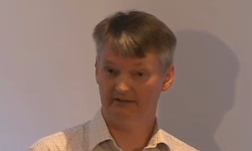Description:
Although people usually relate fungi with diseases, Dr. Anne Pringle provides an overview of the vastly diverse and complex world of fungi, and provides examples of the beneficial roles that fungi have on Earth. For example, although some fungi have been associated with devastating infections that threaten harvests every year, other fungi are mutualists needed for the healthy development of plants and animals.
In her second lecture, Pringle explains how one can use a “reverse ecology” approach to describe and characterize different organisms and their habitats, by studying their genes. Her laboratory used this approach to study the origins of the Bay Area Amanita phalloides. Although Amanita phalloides was thought to be an invasive species, historical records were mostly descriptive and hard to use as concrete evidence of the species’ biogeography. Using genetic information, the Pringle laboratory was able to definitively prove that early samples identified as Amanita phalloides in the US are distinct from the European species. They also used molecular data to document the symbiotic associations between Amanita phalloides and plants, proving the efficacy of these approaches to study species that are hard to grow in the lab.
In her third lecture, Pringle provides an overview of convergent interactions, defined as the independent emergence of multi-species interactions with similar physiological or ecological functions. For example, multiple plant lineages have independently evolved interactions with fungi in order to exchange resources and form what are known as mycorrhizal symbioses. To further understand how convergent interactions are formed, the Pringle laboratory studied the evolution of plants that have “pitcher”-like structures as well as the mycorrhizal symbiosis in the Amanitagenus.
Medical and Patient education videos
-
Title
Description
-

This patient had severe kyphoscoliosis as a child with insertion of spinal rods in early adulthood. She is a life-long non-smoker. She first presented in 2001 with an irritating cough and several treatments with antibiotics failed to alleviate it.Aspergillus precipitin titre was high and she was initially diagnosed with chronic pulmonary aspergillosis with one cavity containing an aspergilloma. This patient developed resistance to all azole therapies.
-

Sources of aspergillus and how can I clean up at home? By Professor Malcolm Richardson
-

Informal recording of a meeting for patients. By Philip Langridge Aspergillosis Specialist Physiotherapist.
-

Simple steps for patients to loosen phlegm in the lungs and easily produce sputum samples for testing in the clinic. Designed for aspergillosis patients or any patients with respiratory illnesses.
-

A double lung transplant has been carried out on a young cystic fibrosis patient, who had more than 10 aspergillomas in her lung. Clip shown on BBC North West news shows an interview with Becky and Prof Denning.
-

Short history from patient’s wife. Brief history and experiences of attending National Aspergillosis Centre
-

Immunodiffusion technique to test for serum antibodies in patients – describes how to set up a test for the presence of antibodies in serum which are specific to various fungal pathogens. The technique is used to test and measure titres of these antibodies in the serum of infected patients.
-

21-year-old medical student Jo Armstead has made a major discovery, which will help doctors better able to diagnose and treat patients with Cystic Fibrosis (CF). Jo spent hundreds of hours accessing data from 30 countries to discover that there are over 75,000 people with the genetic disorder, of whom half are over 18 years – with 50 per cent infected by the fungus, Aspergillus. Professor David Denning, Director of the NHS National Aspergillosis Centre and Professor of Infectious Diseases in Global Health at the University of Manchester explains: “The life expectancy of people with CF has been increasing, but aspergillosis has a major negative impact on many. By painstakingly crunching the numbers, Jo has helped us better understand the scale of the challenge which will lead to better diagnostics and treatment strategies.” Prof Denning and Jo were interviewed on BBC-1 Breakfast last Sunday June 29th.
-

Literary event – Manchester Literature Festival hosted at Manchester Museum to increase awareness of Aspergillosis, in October 2013. Exploring literature, music and medicine.
-

Fungi are eukaryotic organisms which possess a unique cell wall and cell membrane that can serve as targets for antifungal agents. The echinocandin class of antifungal agents target the cell wall of fungi. Watch this animation for more information.
